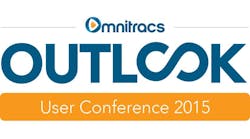DALLAS. Omnitracs said it will be phasing out its current hardware platforms sometime in 2016 in favor of a single, scalable system. Dubbed “Project OTIS” – short for Omnitracs Telematics Integrated Solution – the company said a prototype already exists, with beta testing expected to begin later in the year.
The new hardware is designed to be installed in about 30 minutes and includes connectivity to mobile devices as well as a screen installed in the vehicle so that fleets “can follow the driver and follow the vehicle,” noted Dan Speicher, chief technology officer (CTO) for Omnitracs.
He shared details regarding “Project OTIS” with customers and supplier partners during the day two opening general session of Omnitracs Outlook 2015 being held here this week.“There are four existing assets we can draw on,” Speicher (at right) said: mobility, telematics, location-based services and advanced analytics.
“We also have a comprehensive applications portfolio [so] if we can combine all this into a single platform, no one can compete with us,” he explained.
Bringing all these capabilities together will also give Omnitracs the opportunity to further leverage its advanced analytics capabilities on behalf of customers, Speicher stressed – enabling fleets to see predictions of future events, remediation options and conversion history, along with other information.
Other benefits for customers include what Speicher described as “a world-class user experience, which will come to encompass features such as AV notifications, text-to-speech, off-line login, multi-lingual capabilities and, in the future, voice recognition.”
The OTIS platform is being split into two iterations – dubbed OTIS 1 and OTIS 2 for now – which will replace all current platforms including the MCP 50, MPC 110, MCP 200, MCP 100 and TT 210 devices. Speicher added that the company would continue to support existing platforms indefinitely. “We don’t want anyone losing sleep over this,” he said.
For Omnitracs, the move to a single platform opens up the opportunity to invest more time and resources in software development, as well as making it easier to work with OEMs and to serve mixed fleets, Speicher indicated. It is also expected to speed time to market by, among other things, simplifying the testing and validation process.




